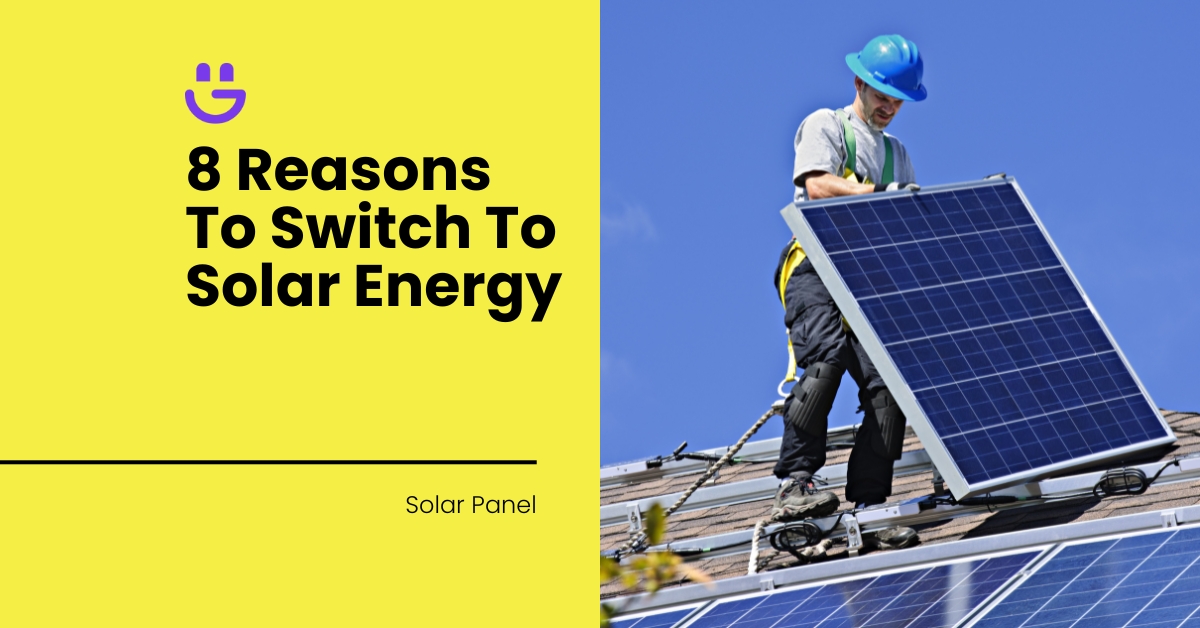Last Updated on November 14, 2025
Yes, solar panels can absolutely be installed on a tile roof. Tile roofs are popular and common all over the UK so it’s good news that this roof type is a viable surface for a solar system.
However, you don’t want to risk cracking brittle tiles during the installation. To safely install solar panels on this roof covering, some tiles must be removed to allow mounting brackets to be affixed. This slightly tricky process is labour-intensive, so installing solar on a tile roof is around 20-25% more expensive than most other installations.
If you’re wondering how can solar panels be installed on a tile roof, this guide breaks it down in easy, practical steps. We also discuss the costs and benefits of solar panels and spotlight alternative ways of installing solar on your tile roof.
Contents
- 1 How Are Solar Panels Installed On Tile Roofs?
- 2 How Long Does It Take to Install Solar Panels on a Tile Roof?
- 3 How Much Does It Cost to Install Solar Panels On Tile Roofs?
- 4 Are There Other Solar Panel Options for a Tile Roof?
- 5 Get A Solar Panel Installation Quote Today
- 6 FAQs
- 7 Our Verdict
How Are Solar Panels Installed On Tile Roofs?
Here are the processes and steps involved in installing solar panels on tile roofs.
Professional assessment
Before installing solar on any roof a professional inspection and assessment is crucial. A certified solar panel installer can confirm the structural integrity of your roof and how suitable it is for a solar installation.
Your roof’s pitch and orientation are key factors. The ideal roof pitch for solar panel installation is between 30-40 degrees. In the UK south-facing roofs benefit from the most sunlight; west and east-facing structures also get a decent share of sun.
The type and condition of your existing roof tiles are also relevant. Let’s touch on this briefly:
- Clay roof tiles are durable are lighter than concrete tiles which means the roof carries less weight which is positive when contemplating solar.
- Concrete roof tiles are versatile and affordable but weigh more than clay tiles.
- Whether you have a concrete tile roof or clay tile roof, if tiles are cracked and broken sections of tiling may have to be replaced to ensure the integrity of the solar panel installation.
Project planning
Project planning is essential to address several questions:
- How much solar power do you hope to generate?
- How many panels do you need?
- How many panels will your roof effectively hold?
- What’s your budget?
- What is the best overall system for your property?
Planning permissions and building regulations must also to considered. In the UK, planning permission for installing solar panels isn’t typically required (this exemption doesn’t apply to listed buildings and properties in conservation areas).
The discussions will help determine the best solar solution for you – including design, layout, and the type and size of panels.
9-step guide to installing solar panels on a tiled roof
Step 1: Mark the installation area
The solar array has been ordered and is on-site. Now it’s time to set up scaffolding and hit the roof. The solar installer usually first marks out the solar installation footprint, showing where the panels will lie.
Step 2: Remove selected tiles
Selected tiles must be removed to get to the roof rafters. The tiles are unscrewed (where necessary), carefully levered, and lifted out. It’s sometimes easiest to remove a full column of tiles to access the rafters.
Step 3: Secure the mounting brackets
The roof rafters are located and mounting brackets are securely attached. The brackets must be carefully aligned so that they are level with each other.
Step 4: Fix flashing sheets
Flashing sheets are fixed around the bracket point to ensure the area is waterproof. Proper waterproofing is crucial to prevent leaks and water damage. Special sealants can be used if necessary.
Step 5: Replace the tiles
The tiles that were removed must be cut and trimmed so that they can be fitted back around the brackets. They must fit snugly in place, leaving no gaps. Tiles that are damaged should be replaced with new ones.
Step 6: Attach the rails
Rails or tracks are then bolted and secured to the mounting hardware taking care that the tracks are aligned and level.
Step 7: Install the panels
The solar panels are fitted onto the rails and secured in place. To form the solar array the panels are connected as a system.
Step 8: Wiring
The system must then be wired up. This involves properly and safely connecting the panels, the inverter, the batteries, and the distribution board or fuse box.
Step 9: System testing
Testing the solar panel system checks that it is generating power correctly. Testing also ensures all electrical connections are safe and functioning as they should.
How Long Does It Take to Install Solar Panels on a Tile Roof?
Solar Installations on tile roofs usually take slightly longer than most other surface types because of the special care involved. A home installation on a tile roof may take two or three days, with more complex jobs lasting most of the week.
These time estimates relate to the entire installation including building scaffolding (and later dismantling it), installing the inverter and battery, running cabling, and connecting and testing the entire system.
Several reasons could cause the installation to take longer than expected:
- The roof is steep and difficult to work on.
- Tile quality is poor and many tiles need replacing.
- Bad weather drives installers off the roof.
- There are challenges with running cable from the panels to the inverter.
- A faulty panel or incorrect connection delays successful completion.
How Much Does It Cost to Install Solar Panels On Tile Roofs?
The average cost of installing solar panels on a tile roof ranges from £6,000 to over £13,000 (excluding battery). The size of your property and solar array directly impact the cost.
An apartment or 1-bedroom home with a tile roof could install solar for a little over £5,000 while a bustling household with 6 bedrooms may pay £14,000.
Let’s look at approximate costs across different-sized properties assuming solar panels of 350W which is the average power output for residential installations.
| House Size | Annual Electricity Usage | Solar Panel System Size Requirement | Number of Solar Panels – 350W | Price | Additional: Solar Battery Cost |
|---|---|---|---|---|---|
| 1 bedroom | <2,000 kWh | 3kWh | 6-8 | £6,000 – £7,500 | £2,000 – £2,500 |
| 2 bedroom | 2,000-2,900 kWh | 3.5 kWh – 4kWh | 8-10 | £7,500 – £8,500 | £2,500 – £3,000 |
| 3-4 bedroom | 3,000 – 5,000 kWh | 5kWh | 10-16 | £8,500- £10,500 | £3,000 – £4,500 |
| 5 or more bedrooms | 5,000 – 8,000 kWh | 6kWh | 16-20 | £10,000 – £13,000+ | £4,500 – £7,000+ |
No doubt solar panels are a pricey investment for many. This leads to the question – are solar panels worth it?
Here are 6 reasons to believe they are:
- Energy Saving Trust figures show homes that install solar can save about £500 annually (with SEG).
- A Solar Energy UK report reveals that an annual saving of up to £960 is possible after installing solar PV panels.
- A £1,891 – £2,722 property value increase is also reported.
- Many experts believe that a solar panel investment can pay for itself in 8 or 9 years, especially given the widely-held view that electricity prices will trend upward in the years ahead.
- Solar panels have a lifespan of 20-25 years making them a good long-term investment.
- Above all else, solar is great for the planet. The use of solar power has effectively prevented the emission of millions of tons of carbon dioxide into the Earth’s atmosphere.
Are There Other Solar Panel Options for a Tile Roof?
There are a few different ways to secure solar installation on tile roofs. The mounted solar panel installation is still the most energy-efficient and cost-effective (partially because the air gap beneath the solar panels facilitates cooling and efficiency).
For property owners who don’t like the bolted-on appearance of conventional installations here are two attractive alternatives that don’t alter the roofline.
Solar tiles
Solar tiles are a great solution for homeowners who want to go green without compromising the look of their home. These small, modular tiles integrate naturally with your existing roof. You can order tiles that match your existing clay or concrete tiles and fit flush alongside them.
Solar tiles are slightly pricier than standard solar PV panels and their energy efficiency may be 30% lower due to their smaller surface area and lack of airflow. However, many homeowners agree that aesthetically they’re a winner.
Listed buildings and properties in conservation areas have a better chance of getting permission for a solar installation using this unobtrusive system.
Integrated solar panels
These innovative panels are designed to be installed directly into your roof structure. A section of your existing tiles is removed to create space for the integrated panels. They are fitted to create a uniform, aesthetically pleasing roofline. The difference between these panels and solar tiles is that integrated panels clearly look like solar while solar tiles are made to look like ordinary roof tiles.
Integrated solar panels are durable and compatible with tile roofs of various pitches. Pricing is similar to rack-mounted solar panels. However, with no airflow beneath them, this system is up to 20% less efficient than a raised setup.
Get A Solar Panel Installation Quote Today
Are you committed to reducing your carbon footprint and slashing your energy bills? Are you considering installing solar panels to achieve this? Contact Eco Happy today to receive a free solar installation quote. Our experienced solar panel installers can give you expert advice and guidance about the best solar solution for you, whatever your roof type.
FAQs
Why are south-facing solar panel installations the best?
In the UK, south-facing solar panels are best oriented to capture the maximum amount of sunlight as the sun moves from the east to the west through the day. All else being equal, they generate more solar power than solar panels facing other directions.
What is the easiest roof to install solar panels on?
Asphalt shingles and metal roofs are the easiest and most convenient roof types to install solar panels on as they are robust and can handle the stress of installation without breaking. Slate and tile roofs are more brittle and need more careful handling.
Is it easier to install solar panels on concrete tile roofs than clay tile roofs?
Clay tiles are more brittle than concrete but both are known to chip, crack, and break. This makes both a challenge when it comes to a solar installation so concrete tiles are not significantly easier to work with.
Our Verdict
Solar installations in the UK have skyrocketed in recent years. Adding solar panels to a tile roof offers a great return but the installation process requires a bit more effort compared to other roof materials. Expect to pay 20% more for your installation.
The final price depends on variables like the number of panels needed, your electricity demands, your roof’s size, configuration, and installation difficulty. Costs range from £6,000 for a 1-bedroom home to £13,000 for a larger 5-bedroom property (excluding battery storage).
When you fit solar panels be sure to take advantage of smart meters, SEG, and storage batteries to gain the full rewards. You will be joining the thousands of homeowners who are enjoying the benefits of clean, renewable energy and lower electricity bills by making the switch to solar.





Tom Allen
Solar Expert